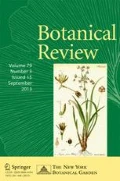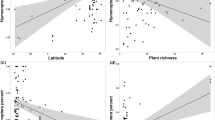Abstract
Allelopathy and resource competition have often been suggested to explain plant-plant interference. Many studies have attempted to separate these two mechanisms of interference to demonstrate either as a probable cause of an observed growth pattern. We, however, are of the opinion that separating allelopathy from resource competition is essentially impossible in natural systems. Furthermore, any experimental design to separate allelopathy and resource competition will create conditions that will never occur in nature. In this article, the ecological interaction between allelopathy and resource competition in natural systems is discussed.
Similar content being viewed by others
Literature Cited
Aldrich, R. J. 1987. Interference between crops and weeds. Pp. 300–312in G. R. Waller (ed.), Allelochemicals: role in agriculture and forestry. ACS Symposium Series 330. American Chemical Society, Washington, DC.
Appel, H. M. 1993. Phenolics in ecological interactions: the importance of oxidation. J. Chem. Ecol.19: 1521–1552.
Ardi. 1986. Influence between sweet-com (Zea mays L.) and purple nutsedge (Cyperus rotundus L.) at different irrigation levels. M.S. thesis, University of Hawaii, Honolulu.
Ball, D. M. &C. S. Hoveland. 1978. Alkaloidal levels inPhalaris aquatica L. as affected by environment. Agron. J.70: 977–981.
Bhowmik, P. C. &J. D. Doll. 1983. Growth analysis of corn and soybean responses to allelopathic effects of weed residues at various temperatures and photosynthetic photon flux densities. J. Chem. Ecol.9:1263–1280.
——. 1984. Allelopathic effects of annual weed residue on growth and nutrient uptake of corn and soybean. Agron. J.76: 383–388.
Black, C. A. 1973. Soil and plant relationships. Ed. 2. Scientific Publishers, Jodhpur, India.
Blum, U. 1996. The use of plant-microbe-soil model system for characterizing allelopathic interactions involving mixtures of phenolic acids and/or other compounds. J. Nematol.28: 259–267.
Bremmer, J. M. &G. W. McCarty. 1988. Effects of terpenoids on nitrification in soil. Soil Sci. Soc. Amer. J.52: 1630–1633.
Bryant, J. P., F. S. Chapin III &D. R. Klein. 1983. Carbon/nutrient balance of boreal plants in relation to vertebrate herbivory. Oikos40: 357–368.
Campbell, R. B. &G. T. Seaborn. 1972. Yield of flue-cured tobacco and levels of soil oxygen in lysimeters with different water table depths. Agron. J.64: 730–733.
Chapin, F. S., III. 1995. New cog in the nitrogen cycle. Nature377: 199–200.
Chou, C. H. 1983. Allelopathy in agroecosystems in Taiwan. Pp. 27–64in C. H. Chou & G. R. Waller (eds.), Allelochemicals and pheromones. Institute of Botany, Academia Sinica, Monograph Series No. 5, Taipei.
—. 1989a. Allelopathic research of subtropical vegetation in Taiwan. IV. Comparative phytotoxic nature of leachates from four subtropical grasses. J. Chem. Ecol.16: 2149–2159.
—. 1989b. The role of allelopathy in phytochemical ecology. Pp. 19–38in C. H. Chou & G. R. Waller (eds.), Phytochemical ecology: allelochemicals, mycotoxins, and insect pheromones and allomones. Institute of Botany, Academia Sinica, Monograph Series No. 9, Taipei.
— &Lee K. J. 1988. Effects of levels of nitrogen fertilizers on the allelopathic potential of pangola grass and weeds. Bot. Bull. Acad. Sinica29: 39–47.
Curl, E. A. &B. Truelove. 1986. The rhizosphere. Springer-Verlag, New York.
Dao, T. H. 1987. Sorption and mineralization of plant phenolic acids in soil. Pp. 358–370in G. R. Waller (ed.), Allelochemicals: role in agriculture and forestry. ACS Symposium Series 330, American Chemical Society, Washington, DC.
del Moral, R. 1972. On the variability of chlorogenic acid concentration. Oecologia9: 289–300.
Dement, W. A. &H. A. Mooney. 1974. Seasonal variation in the production of tannins and cyanogenic glycosides in the chaparral shrub,Heteromeles arbutifolia. Oecologia15: 65–76.
Eck, H. V. 1976. Hydrocyanic acid potentials in leaf blade tissue of eleven grain sorghum hybrids. Agron. J.68: 349–351.
Einhellig, F. A. 1987. Interactions among allelochemicals and other stress factors of the plant environment. Pp. 343–357in G. R. Waller (ed.), Allelochemicals: role in agriculture and forestry. ACS Symposium Series 330, American Chemical Society, Washington, DC.
—. 1989. Interactive effects of allelochemicals and environmental stress. Pp. 101–118in C. H. Chou & G. R. Waller (eds.), Phytochemical ecology: allelochemicals, mycotoxins, and insect pheromones and allomones. Institute of Botany, Academia Sinica, Monograph Series No. 9, Taipei.
—. 1996. Interactions involving allelopathy in cropping systems. Agron. J.88: 886–893.
Fisher, R. F., R. A. Woods &M. R. Glavicic. 1978. Allelopathic effects of goldenrod and aster on young sugar maple. Canad. J. Forest. Res.8: 1–9.
Fox, R. H., R. J. K. Meyers &I. Vallis. 1990. The nitrogen mineralization rate of legume residues in soil as influenced by their polyphenol, lignin, and nitrogen contents. Pl. & Soil129: 251–259.
Freeman, G. G. &N. Mossadeghi. 1971. Water regime as a factor determining flavor strength in vegetables. Biochem. J.124: 61F-62F.
——. 1972. Influence of sulfate nutrition on flavor component of three cruciferous plants: radish (Raphanus satuivus), cabbage (Brassica oleracea capitata) and white mustard (Sinapis alba). J. Sci. Food Agric.23: 387–402.
Gershenzon, J. 1984. Changes in the levels of plant secondary metabolites under water and nutrient stress. Recent Adv. Phytochem.18: 273–320.
— &J. Croteau 1991. Terpenoids. Pp. 165–219in G. A. Rosenthal & M. R. Berenbaum (eds.), Herbivores, their interactions with secondary metabolites. Vol. 1. The chemical participants. Ed. 2. Academic Press, New York.
Gilmore, A. R. 1977. Effects of soil moisture stress on monoterpenes in loblolly pine. J. Chem. Ecol.3: 667–676.
Grace, J. B. &D. Tilman 1990. Perspectives in plant competition. Academic Press, New York.
Grime, J. P. 1977. Evidence for the existence of three primary strategies in plants and its relevance to ecological and evolutionary theory. Amer. Naturalist111: 1169–1194.
—. 1979. Plant strategies and vegetation processes. John Wiley, New York.
Hall, A. B., U. Blum &R. C. Fites. 1982. Stress modification of allelopathy inHelianthus annuus L. debris on seed germination. Amer. J. Bot69: 776–783.
Harper, J. L. 1977. Population biology of plants. Academic Press, London.
Hegnauer, R. 1966. Chemotaxonomie der pflanzen, Vol. IV. Birkhauser Verlag, Basel.
Inderjit. 1996. Plant phenolics in allelopathy. Bot. Rev. (Lancaster)62: 186–202.
-. 1997. Influence ofPluchea lanceolata on selected soil properties. Amer. J. Bot., in press.
— &K. M. M. Dakshini. 1995. On laboratory bioassays in allelopathy. Bot. Rev. (Lancaster)61: 28–44.
— &A. U. Mallik. 1997. Effect of phenolic compounds on selected soil properties. Forest. Ecol. Managem.92: 11–18.
—,S. Kaur &K. M. M. Dakshini. 1996. Determination of allelopathic potential of a weedPluchea lanceolata through a multi-faceted approach. Canad. J. Bot.74: 1445–1450.
Kafkafi, U., B. Bar-Yosef, R. Rosenberg &G. Sposito. 1988. Phosphorus adsorption by kaolinite and montmorillonite: II. Organic anion competition. Soil Sci. Soc. Amer. J.52:1585–1589.
Klein, K. &U. Blum. 1990. Effect of soil nitrogen level on ferulic acid inhibition of cucumber leaf expansion. J. Chem. Ecol.16: 1371–1383.
Koeppe, E. D. E., L. M. Southwick &J. E. Bittell. 1976. The relationship of tissue chlorogenic acid concentrations and leaching of phenolics from sunflowers grown under varying phosphate nutrient conditions. Canad. J. Bot.54: 593–599.
Kohl, K. 1993. Allelopathy and water stress of purple nutsedge (Cyperus rotundus L.). M.S. thesis, University of Hawaii, Honolulu.
Lehman, R. H. &E. L. Rice. 1972. Effect of deficiencies of nitrogen, potassium and sulfur on chlorogenic acids and scopolin in sunflower. Amer. Midl. Naturalist87: 71–80.
McCarty, G. W. &J. M. Bremner. 1986. Effects of phenolic compounds on nitrification in soil. Soil Sci. Soc. Amer. J.50: 920–923.
Majek, W., D. A. Quinton &K. Broersma. 1980. Cyanogenic glycoside levels in Saskatoon service-berry. J. Range Managern.33: 197–199.
Mihaliak, C. A. &D. E. Lincoln. 1985. Growth pattern and carbon allocation to volatile leaf terpenes under nitrate-limiting conditions inHeterotheca subaxillaris (Asteraceae). Oecologia66: 423–426.
Muller, C. H. 1965. Inhibitory terpenes volatilized fromSalvia shrubs. Bull. Torrey Bot. Club92: 38–45.
Nelson, C. E. 1953. Hydrocyanic acid content of certain sorghums under irrigation as affected by nitrogen fertilizer and soil moisture stress. Agron. J.45: 6115–617.
Nilsson, M.-C. 1994. Separation of allelopathy and resource competition by the boreal dwarf shrubEmpetrum hermaphroditum Hagerup. Oecologia97: 1–7.
Northup, R. R., Y. Zengshou, R. A. Dahlgren &K. A. Vogt. 1995. Polyphenol control of nitrogen release from pine litter. Nature377: 227–229.
Oksanen, L. 1993. Plant strategies and environmental stress: a dialectic approach. Pp. 313–333in L. Fowden, T. Mansfield & J. Stoddart (eds.), Plant adaptation to environmental stress. Chapman & Hall, London.
Palm, C. A. &P. A. Sanchez. 1991. Nitrogen release from the leaves of some tropical legumes as affected by their lignin and polyphenolic contents. Soil Biol. Biochem.23: 83–88.
Putnam, A. R. 1985. Weed allelopathy. Pp. 132–155in S. O. Duke (ed.), Weed physiology. CRC Press, Boca Raton, Florida.
— &L. A. Weston. 1986. Adverse impacts of allelopathy in agricultural systems. Pp. 43–56in A. R. Putnam & C. S. Tang (eds.), The science of allelopathy. John Wiley & Sons, New York.
Rice, E. L. 1984. Allelopathy. Ed. 2. Academic Press, Orlando, Florida.
—. 1986. Allelopathic growth stimulation. Pp. 23–42in A. R. Putnam & C. S. Tang (eds.), The science of allelopathy. John Wiley & Sons, New York.
—. 1995. Biological control of weeds and plant diseases: applied aspect of allelopathy. University of Oklahoma Press, Norman.
—,W. T. Penfound &L. M. Rohrbaugh. 1960. Seed dispersal and mineral nutrition in succession in abandoned fields in central Oklahoma Ecology41: 224–228.
Richardson, M. D. &C. W. Bacon. 1993. Cyclic hydroxamic acid accumulation in corn seedlings exposed to reduced water potentials before, during, and after germination. J. Chem. Ecol.19: 1613–1624.
Schlesinger, W. H. 1991. Biogeochemistry: an analysis of global change. Academic Press, San Diego.
Shindo, H. &P. M. Huang. 1984. Significance of Mn(IV) oxides in abotic formation of organic nitrogen complexes in natural environment. Nature308: 87–88.
Stewart, G. R. &F. Lahrer. 1980. Accumulation of ammo acids and related compounds in relation to environmental stress. Pp. 609–635in B. J. Mifflin (ed.), Biochemistry of plants. Vol. 5, Amino acid and derivatives. Academic Press, New York.
Stowe, L. G. &A. Osborn. 1980. The influence of N and P levels on the phytotoxicity of phenolic compounds. Canad. J. Bot.58: 1149–1153.
Svenningsson, H., P. Sundin &C. Liljenberg. 1990. Lipids, carbohydrates and amino acids exuded from the axenic roots of rape seedling exposed to water deficit stress. Pl. Cell Environm.13: 155–162.
Tan, K. H. &A. Binger 1986. Effect of humic acid on aluminum toxicity in corn plants. Soil Sci.141: 20–25.
Tang, C. S., S. H. Chang, D. Hoo &K. H. Yanagihara. 1975. Gas chromatographic determination of 2(3)-benzoxazolionones from cereal plants. Phytochemistry14: 2077–2079.
Tang, C. S., W. F. Cai, K. Kohl &R. K. Nishimota. 1995. Plant stress and allelopathy. Pp. 142–157 m Inderjit, K. M. M. Dakshini & F. A. Einhellig (eds.), Allelopathy: organisms, processes, and applications. American Chemical Society, Washington, DC.
Tanrisever, N., F. R. Fronczek, N. H. Fischer &G. B. Williamson. 1987. Ceratiolin and other flavonoids fromCeratiola ericoides. Phytochemistry26:175–179.
Tevini, M., W. Iwanzik &A. H. Teramura. 1983. Effects of UV-B radiations on plants during mild water stress II. Effects on growth, protein and flavonoid content. Z. Pflanzenphysiol.110: 459–467.
Tsai, S. D. &G. W. Todd. 1972. Phenolic compounds of wheat leaves under drought stress. Phyton30: 67–75.
Vitousek, P. M. &R. W. Howarth. 1991. Nitrogen limitation on land and in the sea: how can it occur? Biogeochemistry13: 87–115.
Waller, G. R. &E. K. Nowacki. 1978. Alkaloid biology and metabolism in plants. Plenum Press, New York.
Wang, M. C. &P. M. Huang. 1989. Pyrogallol transformations as catalyzed by oxides of Mn, Fe, Al and Si. Pp. 195–207in C. H. Chou & G. R. Waller (eds.), Phytochemical ecology: allelochemicals, mycotoxins, and insect pheromones and allomones. Institute of Botany, Academia Sinica, Monograph Series No. 9, Taipei.
Williamson, G. B. 1990. Allelopathy, Koch’s postulates and the neck riddle. Pp. 143–162in J. B. Grace & D. Tilman (eds.), Perspectives in plant competition. Academic Press, New York.
White, C. S. 1986. Volatile and water-soluble inhibitors of nitrogen mineralization and nitrification in a ponderosa pine ecosystem. Biol. Fertil. Soils2: 97–104.
—. 1994. Monoterpenes: their effect on ecosystem nutrient cycling. J. Chem. Ecol.20: 1381–1406.
Zimdahl, R. L. 1993. Fundamentals of weed science. Academic Press, New York.
Zucker, P. J. 1963. The influence of light on the synthesis of protein and chlorogenic acid in potato tuber tissue. Pl. Physiol.38: 575–580.
Author information
Authors and Affiliations
Rights and permissions
About this article
Cite this article
Inderjit, del Moral, R. Is separating resource competition from allelopathy realistic?. Bot. Rev 63, 221–230 (1997). https://doi.org/10.1007/BF02857949
Issue Date:
DOI: https://doi.org/10.1007/BF02857949




